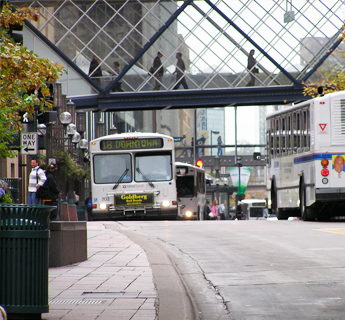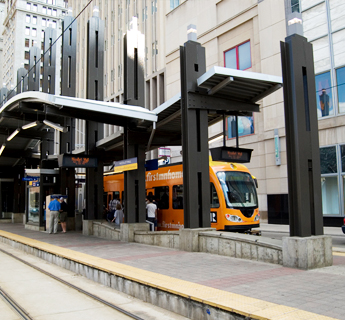Transit: Increase the frequency, speed, and reliability of the public transit system in order to increase ridership and support new housing and jobs.


2016 marked the 6th consecutive year in a row that Metro Transit ridership surpassed 80 million annual rides. Metro Transit’s system includes light rail, high frequency, rapid, commuter, and local bus lines as well as Metro Mobility and community partnerships that extend the reach of transit use to the outer edges of the metro area. In 2015, 13.1% of the working population over 16 in Minneapolis used public transportation to commute to work. In the core of downtown, transit carries 45-54% of peak period passenger trips. Approximately 18% of Minneapolis households are without access to a personal vehicle, making transit, car-sharing or carpooling, or non-motorized transportation a necessity for many in the city.
Public transit is essential to providing transportation choices and accessibility that aid in combating climate change and reducing economic disparities. As our city’s population grows, it will be necessary to increase the frequency, speed, and reliability of the public transit system in order to increase ridership and support new housing and jobs.
 ACTION STEPS
ACTION STEPS
The City will seek to accomplish the following action steps to increase the frequency, speed, and reliability of the public transit system in order to increase ridership and support new housing and jobs.
- Actively shape and define the City’s transit vision and framework, with a focus on outcomes rather than modes.
- Partner with Metro Transit and other agencies to pursue new transit projects of high impact.
- Work with regional partners to make transit more effective at the local level on both major regional projects as well as the local network.
- Support Metro Transit’s efforts to install higher quality infrastructure (bus shelters, heating, lights) and coordinate these improvements with street improvement projects and new development.
- Support Metro Transit's efforts to monitor and maintain transit facilities, including landscaping, trash removal, and cleaning of bus shelters.
- Partner with Metro Transit and other transit providers to provide reliable service in Minneapolis through shorter transit headways and transit advantages, including priority transit lanes and signal priority and preemption.
- Coordinate major transit projects with housing, economic development, and other transportation-related capital improvement investments, including connections to transit via pedestrian routes and bicycling facilities.
- Ensure that high frequency bus routes serve areas with the highest residential, employment and commercial densities.
- Support the creation of MnPASS for transit advantages to encourage more regional transit use into the downtown core; the conversion of general purpose freeway lanes to MnPASS lanes is preferred over capacity expansion.
- Increase and improve transit and mobility options within, to, from, and around Downtown to support commerce and density.

